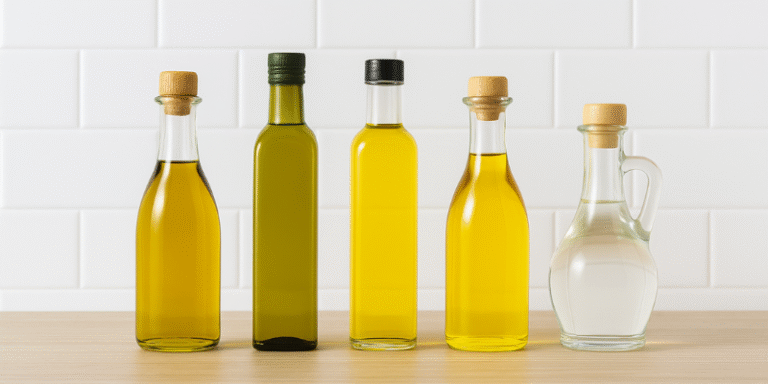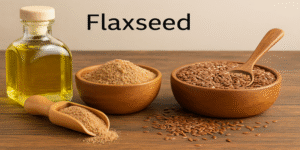Cooking oils are a staple in kitchens across the globe, forming the foundation of countless meals. With increasing awareness of health and nutrition, the question “Which oils should we be using for cooking?” has taken centre stage. The answer is not straightforward, as the ideal cooking oil depends on several factors including smoke point, fatty acid composition, nutritional benefits, and culinary application.
1.0 Understanding Fats in Cooking Oils
Fats can be categorised into three primary types: saturated fats, monounsaturated fats (MUFAs), and polyunsaturated fats (PUFAs). Each of these behaves differently when heated and affects the human body in unique ways. Saturated fats, typically found in animal products and tropical oils like coconut oil, are solid at room temperature. MUFAs and PUFAs are liquid at room temperature and are found in varying proportions in plant-based oils.
According to Gropper and Smith (2021), the human body requires dietary fats for energy, cell structure, and the absorption of fat-soluble vitamins. However, excessive intake of certain fats—especially saturated and trans fats—has been linked to cardiovascular disease.
2.0 Smoke Point and Cooking Stability
The smoke point of an oil is the temperature at which it begins to break down and produce smoke, indicating the degradation of fats and the production of harmful compounds such as aldehydes. Oils with high smoke points are better suited for frying and high-heat cooking, while those with lower smoke points are better for salad dressings or low-heat sautéing.
According to Choe and Min (2007), oils with higher saturated and monounsaturated fat content tend to be more stable when heated. For instance, avocado oil, which is rich in MUFAs, has a smoke point around 270°C, making it ideal for high-heat applications like frying.
3.0 Healthiest Cooking Oils
3.1 Olive Oil
Olive oil, particularly extra virgin olive oil (EVOO), is rich in MUFAs and antioxidants such as polyphenols. It is the cornerstone of the Mediterranean diet, associated with reduced cardiovascular risk and improved longevity.
EVOO has a relatively moderate smoke point (~190–210°C) but is stable due to its antioxidant content. It is ideal for low to medium-heat cooking and salad dressings. Refined olive oil, with a higher smoke point, can be used for frying.
3.2 Avocado Oil
Avocado oil is one of the most versatile cooking oils, boasting a high smoke point (~270°C) and a fatty acid profile dominated by MUFAs. It is also rich in vitamin E and other antioxidants. Due to its neutral flavour and heat stability, it is suitable for all cooking methods, including deep frying and roasting.
3.3 Rapeseed (Canola) Oil
Rapeseed oil, especially the cold-pressed variety, contains a good balance of omega-3 and omega-6 PUFAs, as well as a considerable amount of MUFAs. It is low in saturated fat and has a smoke point of approximately 204°C. The British Heart Foundation (2024) recommends rapeseed oil as a heart-healthy choice.
3.4 Sunflower Oil
Sunflower oil is high in vitamin E and PUFAs, particularly linoleic acid. High-oleic sunflower oil variants have a higher proportion of MUFAs, making them more stable at high temperatures. According to Warner and Gupta (2005), high-oleic sunflower oil is preferable for frying compared to traditional sunflower oil.
3.5 Coconut Oil
Coconut oil is predominantly saturated fat, which makes it very heat stable. Its smoke point is around 177°C. While sometimes marketed as a health food, the high saturated fat content is a concern. The American Heart Association advises limiting saturated fat due to its potential to raise LDL cholesterol.
However, some studies suggest that the medium-chain triglycerides (MCTs) in coconut oil may have a different metabolic effect than long-chain saturated fats. More research is needed to confirm these claims.
4.0 Oils to Limit or Avoid
4.1 Partially Hydrogenated Oils
These contain artificial trans fats, which have been unequivocally linked to increased risk of heart disease and stroke. While many countries, including the UK, have significantly reduced trans fats, it is still important to check food labels for hydrogenated oils.
4.2 Corn and Soybean Oils
While rich in omega-6 PUFAs, these oils can contribute to an imbalanced omega-6 to omega-3 ratio, which may promote inflammation if not balanced with sufficient omega-3 intake.
4.3 Environmental and Culinary Considerations
Beyond health, environmental sustainability and culinary suitability are also worth considering. For example, palm oil is widely used in commercial cooking due to its low cost and high stability, but its production raises concerns about deforestation and habitat loss.
From a culinary perspective, oils differ in taste. Extra virgin olive oil adds a peppery, fruity flavour, ideal for Mediterranean dishes, while neutral oils like canola or refined avocado oil are better for dishes where the oil should not dominate the flavour profile.
The choice of cooking oil should be guided by health, cooking method, and taste preference. Olive oil and avocado oil stand out as excellent all-round choices due to their balance of health benefits and cooking stability. Rapeseed oil is another heart-friendly and affordable option widely available in the UK. While coconut oil and palm oil offer heat stability, their high saturated fat content or environmental impact makes them less favourable for regular use.
Ultimately, a varied diet that includes different healthy fats in moderation is the most sustainable approach. It’s not just about choosing the “best” oil, but about understanding how each fits into a balanced, heart-conscious cooking practice.
References:
British Heart Foundation, 2024. Fats explained: What are good and bad fats? [online] Available at: https://www.bhf.org.uk/informationsupport/support/healthy-living/healthy-eating/fats-explained [Accessed 26 July 2025].
Choe, E. and Min, D.B., 2007. Chemistry of deep-fat frying oils. Journal of Food Science, 72(5), pp.R77–R86.
Covas, M.I., 2007. Olive oil and the cardiovascular system. Pharmacological Research, 55(3), pp.175–186.
Estruch, R. et al., 2013. Primary prevention of cardiovascular disease with a Mediterranean diet. New England Journal of Medicine, 368(14), pp.1279–1290.
Gropper, S.S. and Smith, J.L., 2021. Advanced Nutrition and Human Metabolism. 8th ed. Boston: Cengage Learning.
Gunstone, F.D., 2011. Vegetable Oils in Food Technology: Composition, Properties and Uses. 2nd ed. Oxford: Wiley-Blackwell.
Mozaffarian, D., Katan, M.B., Ascherio, A., Stampfer, M.J. and Willett, W.C., 2006. Trans fatty acids and cardiovascular disease. New England Journal of Medicine, 354(15), pp.1601–1613.
Sacks, F.M. et al., 2017. Dietary fats and cardiovascular disease: A presidential advisory from the American Heart Association. Circulation, 136(3), pp.e1–e23.
Simopoulos, A.P., 2002. The importance of the omega-6/omega-3 fatty acid ratio in cardiovascular disease and other chronic diseases. Experimental Biology and Medicine, 226(6), pp.674–688.
St-Onge, M.P. and Bosarge, A., 2008. Weight-loss diet that includes consumption of medium-chain triacylglycerol oil leads to a greater rate of weight and fat mass loss than does olive oil. The American Journal of Clinical Nutrition, 87(3), pp.621–626.
Warner, K. and Gupta, M., 2005. Frying quality and stability of high-oleic corn oils. Journal of the American Oil Chemists’ Society, 82(3), pp.215–221.
Wong, M., O’Hare, T. and Gidley, M., 2010. Avocado oil: Characteristics, properties and applications. Food Australia, 62(7), pp.288–291.
WWF, 2024. Palm oil. [online] Available at: https://www.worldwildlife.org/industries/palm-oil [Accessed 26 July 2025].









